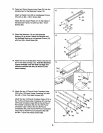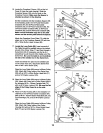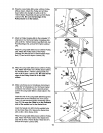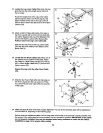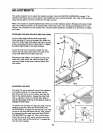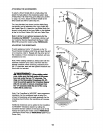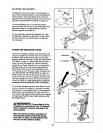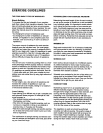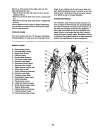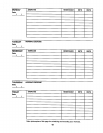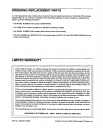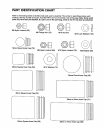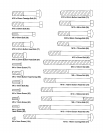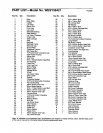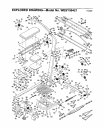
EXERCISE GUIDELINES
THE FOUR BASIC TYPES OF WORKOUTS
Muscle Building
To increase the size and strength ofyour muscles,
pushthem closeto their maximum capacity.Your mus-
cles willcontinuallyadapt and grow as you progres-
sively increase the intensityof your exercise.You can
adjustthe intensitylevelof an individualexercise in
two ways:
• by changingthe amountof resistance used
• by changingthe number of repetitionsor sets per-
formed. (A=repetition" isone complete cycleof an
exercise, such as one sit-up.A "set"is a series of
repetitions.)
The properamount of resistance for each exercise
depends uponthe individualuser. You mustgauge
your limitsand select the amountof resistancethat is
rightfor you. Begin with 3 sets of 8 repetitionsfor each
exercise you perform. Restfor 3 minutesafter each
set. When you can complete 3 sets of 12 repetitions
without difficulty,increasethe amountof resistance.
Toning
You can tone your muscles bypushingthem to a mod-
erete percentage oftheir capacity.Select a moderate
amountof resistanceand increase the number of rep-
etitionsin each set. Complete as many sets of 15 to
20 repetitionsas possiblewithout discomfort.Rest for
1 minuteafter each set. Work your musclesby com-
pletingmore sets ratherthan by using highamountsof
resistance.
Weight Loss
To lose weight, use a low amountof resistanceand
increase the number of repetitionsin each set.
Exercisefor 20 to 30 minutes, restingfor a maximum
of 30 seconds between sets.
Cross Training
Cross trainingis an efficientway to get a complete and
well-balanced fitness program.An example of a bal-
anced programis:
• Plan strengthtrainingworkoutson Monday,
Wednesday, and Friday.
• Plan 20 to 30 minutes of aerobic exercise, such as
runningon a treadmill or riding on an ellipticalor
exercise bike,on Tuesday and Thursday.
• Rest from bothstrengthtrainingand aerobic exercise
for at least one full day each week to give yourbody
time to regenerate.
The combinationof strengthtraining and aerobic exer-
cise willreshape and strengthenyour body, plus devel-
op your heart and lungs.
PERSONALIZING YOUR EXERCISE PROGRAM
Determiningthe exact length of time for each workout,
as well as the number of repetitionsor sets completed,
is an individualmatter. It is importantto avoidoverdo-
ing itdudngthe firstfew monthsofyour exercise pro-
gram.You shouldprogress at your own pace and be
sensitiveto your body'ssignals.If you experience pain
or dizziness at any timewhile exercising,stop immedi-
ately and begincoolingdown. Find outwhat iswrong
beforecontinuing.Remember that adequate rest and a
properdiet are importantfactors in any exercise pro-
gram.
WARMING UP
Begin each workoutwith5 to 10 minutesof stretching
and lightexercise to warm up. Warmingup prepares
your bodyfor more strenuousexercise by increasing
circulation,raisingyour bodytemperature and deliver-
ingmore oxygen toyour muscles.
WORKING OUT
Each workoutshouldinclude6 to 10 differentexercis-
es. Select exercisesfor every major musclegroup,
emphasizingareas that youwant to develop most.To
give balance and vadety to yourworkouts,vary the
exercisesfrom sessionto session.
Schedule yourworkoutsfor the time ofday when your
energy level isthe highest.Each workoutshould be
followedbyat least one day of rest. Once you findthe
schedulethat is rightfor you,stick with it.
EXERCISE FORM
Maintainingproperform is an essentialpart of an
effectiveexercise program.This requiresmoving
throughthe fullrange of motionfor each exercise, and
movingonlythe appropriateparts ofthe body.
Exercisingin an uncontrolledmanner willleave you
feeling exhausted. On the exercise guide accompany-
ingthis manualyou will findphotographsshowingthe
correctform for several exercises,and a listof the
musclesaffected. Refer to the muscle chart on page
18 to findthe namesof the muscles.
The repetitionsin each set shouldbe performed
smoothlyand withoutpausing. The exertion stage of
each repetitionshouldlastabout half as longas the
returnstage. Proper breathing is important.Exhale
duringthe exertion stage ofeach repetitionand inhale
duringthe return stroke.Never hold your breath.
17



